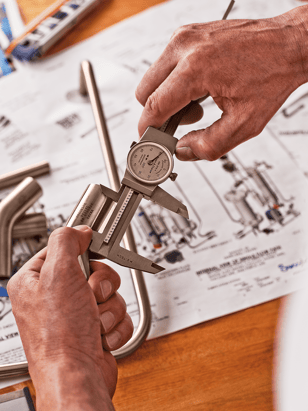Share this
Small Bore Tubing: Driving Down Costs
by Jeff Hopkins on 11/6/19 9:00 AM
Small bore tubing equals savings - cut labor cost as much as 66% compared to installing a pipe system
"Beware of little expenses. A small leak will sink a great ship."
- From Benjamin Franklin
Many companies have recognized the value of tubing for fluid applications of 1/2 inch diameter and smaller, but they still think of pipe when it comes to larger systems of up to 2 inches in diameter.
That traditional approach, however, comes with added costs. It may be time to take another look at small-bore tubing.
Installation, maintenance & performance
 Pipe and tubing systems both perform the basic function of transferring a fluid from one point to another.
Pipe and tubing systems both perform the basic function of transferring a fluid from one point to another.
But the differences in installation, maintenance, and performance can be surprising.
First, consider the components themselves: Pipe is much thicker than tube of the same inside diameter.
Both contain pressure equally well, but pipe is thicker, simply to provide enough material so that threads can be cut.
Also consider the work associated with building or repairing pipe systems. Each bend in a piping system requires a new joint in the system, which means threading, cutting and fitting, or welding. To do that work you'll need pipe stands, dies, cutting oils, sealants, tapes, and more—and possibly a weld permit. Welding also requires hydrostatic testing and can introduce moisture into the system.
And that's just the preliminary work. Assembling pipe requires cutting the pipe, de-burring, then cutting threads, followed by fitting the sections together. Whenever a line must change direction, a new fitting must be introduced adding time to the job and new potential leak points.
Small bore tubing offers a much more efficient strength-to-weight ratio than comparable pipe. There's no need for oils, sealants, dies, complicated equipment, or fire boxes. Tubing must be cut and de-burred, but the similarities end there.
For a directional change with tubing, all you have to do is bend it. That means fewer fittings, while also reducing system turbulence and pressure drop points.
The price of performance

Tubing, fittings, and tools must be designed to work together to ensure a reliable, leak-free, low-maintenance system. Mixing and matching tube and fittings, valves, and more from a number of different suppliers is not a best practice. When installing a system, it’s best to standardize your inventory as much as possible. Source critical components from a single manufacturer to ensure that the parts have been specifically engineered to work together.
Small bore tubing systems can create cost savings in many places in which pipe is currently installed, and Swagelok has a proven track record of providing complete systems and the requisite training.
Just ask
Swagelok Northern California has a great deal of exposure to all aspects of fluid system design and engineering. Whether you have a simple question or a complex challenge, we're glad to hear from you.
More like this:
Share this
- Archive (465)
- Assembly Services (207)
- About (100)
- Seal Support Systems (96)
- Best Practices (88)
- Training Services (74)
- Fittings (51)
- Semiconductor Applications (49)
- Hoses and Flexible Tubing (47)
- Regulators (44)
- Tubing (42)
- Grab Sampling Systems (32)
- Sampling Systems (32)
- Gas Systems (30)
- Services (30)
- Downloads (29)
- Valves (24)
- Application Support (18)
- Orbital Welding (17)
- Case Studies (13)
- Steam Systems (13)
- Frequently Asked Questions (12)
- Tools (12)
- Measurement Devices (7)
- Subsystems (6)
- Thermal Management (6)
- September 2023 (1)
- August 2023 (2)
- June 2023 (1)
- March 2023 (3)
- February 2023 (3)
- January 2023 (4)
- December 2022 (4)
- November 2022 (4)
- October 2022 (4)
- September 2022 (1)
- August 2022 (3)
- July 2022 (2)
- June 2022 (4)
- May 2022 (1)
- April 2022 (2)
- March 2022 (1)
- February 2022 (2)
- January 2022 (3)
- December 2021 (1)
- November 2021 (6)
- October 2021 (6)
- September 2021 (8)
- August 2021 (4)
- July 2021 (3)
- June 2021 (6)
- May 2021 (6)
- April 2021 (7)
- March 2021 (5)
- February 2021 (4)
- January 2021 (6)
- December 2020 (5)
- November 2020 (6)
- October 2020 (6)
- September 2020 (8)
- August 2020 (7)
- July 2020 (8)
- June 2020 (8)
- May 2020 (6)
- April 2020 (9)
- March 2020 (7)
- February 2020 (10)
- January 2020 (21)
- December 2019 (23)
- November 2019 (21)
- October 2019 (22)
- September 2019 (21)
- August 2019 (22)
- July 2019 (23)
- June 2019 (20)
- May 2019 (23)
- April 2019 (22)
- March 2019 (21)
- February 2019 (20)
- January 2019 (21)
- December 2018 (14)
- November 2018 (19)
- October 2018 (23)
- September 2018 (17)
- August 2018 (29)
- July 2018 (11)
- June 2018 (6)
- May 2018 (5)
- April 2018 (4)
- March 2018 (5)
- February 2018 (3)
- January 2018 (3)
- December 2017 (2)
- November 2017 (4)
- October 2017 (3)
- September 2017 (2)
- August 2017 (6)
- July 2017 (4)
- June 2017 (4)
- May 2017 (4)
- April 2017 (3)
- March 2017 (4)
- February 2017 (3)
- January 2017 (3)
- December 2016 (3)
- November 2016 (3)
- October 2016 (3)
- September 2016 (5)
- August 2016 (5)
- July 2016 (4)
- June 2016 (5)
- May 2016 (3)
- April 2016 (4)
- March 2016 (5)
- February 2016 (11)
- January 2016 (1)
- December 2015 (3)
- November 2015 (4)
- October 2015 (3)
- September 2015 (4)
- August 2015 (4)
- July 2015 (8)
- June 2015 (5)
- May 2015 (3)
- April 2015 (4)
- March 2015 (4)
- February 2015 (3)
- January 2015 (4)
- December 2014 (2)
- November 2014 (3)
- October 2014 (4)
- September 2014 (4)
- August 2014 (4)
- July 2014 (5)
- June 2014 (4)
- May 2014 (4)
- April 2014 (5)
- March 2014 (4)
- February 2014 (3)
- January 2014 (4)
- December 2013 (5)
- November 2013 (3)
- October 2013 (4)
- September 2013 (3)
- August 2013 (5)
- July 2013 (5)
- June 2013 (5)
- May 2013 (3)
- April 2013 (6)
- March 2013 (4)
- February 2013 (4)
- January 2013 (8)
- December 2012 (4)
- November 2012 (6)
- October 2012 (6)
- September 2012 (4)
- August 2012 (4)
- July 2012 (4)
- June 2012 (4)

.webp?width=210&height=70&name=StickyLogo%20(5).webp)
